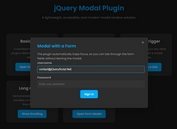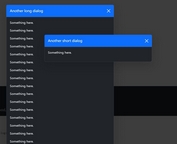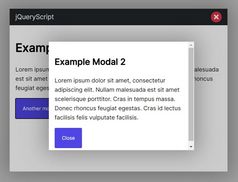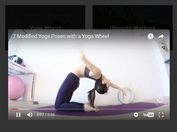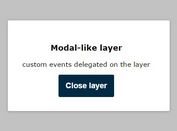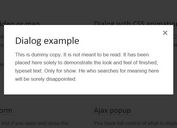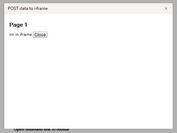Modern, Customizable jQuery Modal Plugin for Tailwind CSS
| File Size: | 12 KB |
|---|---|
| Views Total: | 115 |
| Last Update: | |
| Publish Date: | |
| Official Website: | Go to website |
| License: | MIT |
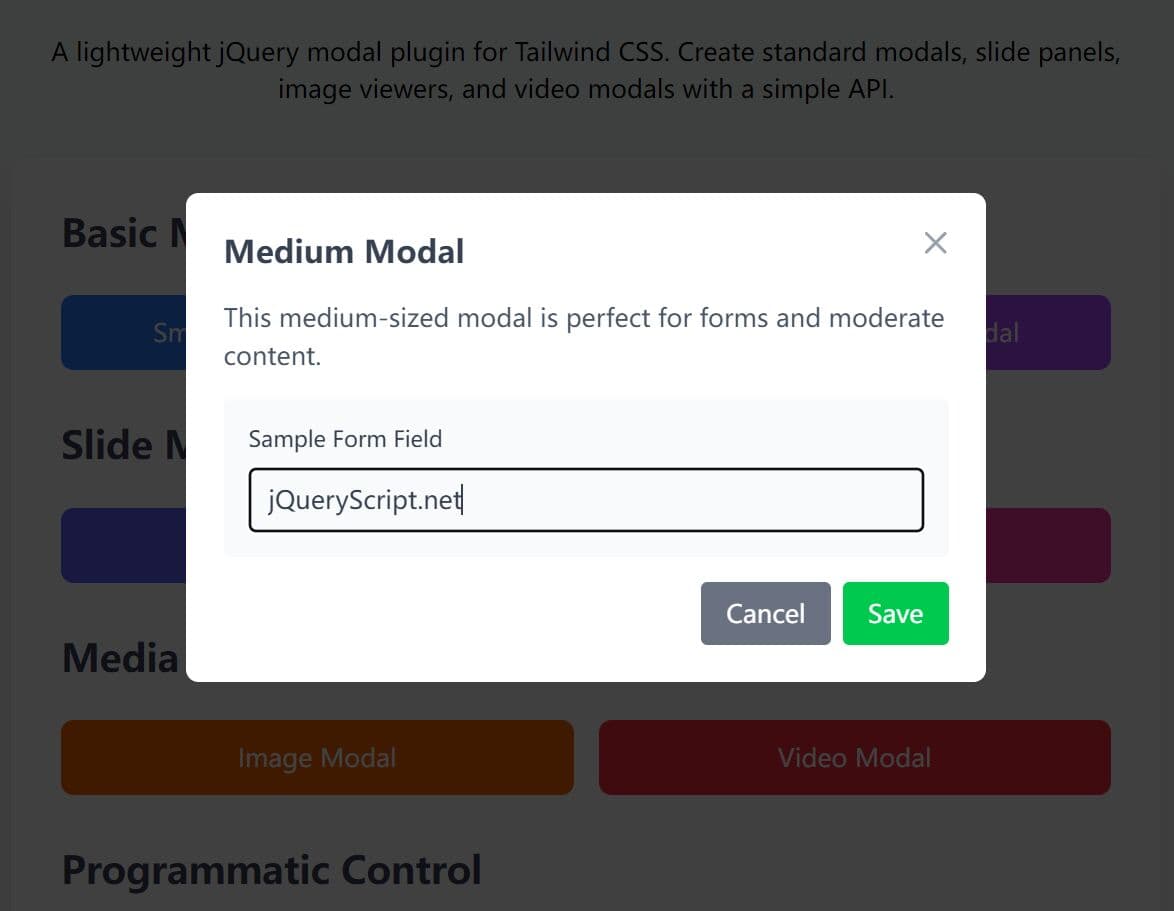
Tailwind-jQuery Modal is a lightweight jQuery modal plugin that creates responsive, modern, customizable modal dialogs for web apps styled with the Tailwind CSS framework.
It combines the utility-first approach of Tailwind CSS with jQuery's DOM manipulation capabilities to provide smooth anf flexible modal experiences across different devices.
Features:
- Multiple Modal Types: Support for standard dialogs, slide panels, and image/video modals.
- Animation Framework: CSS3-powered transitions with customizable timing and effects.
- Media Modal Support: Built-in image zoom and YouTube video embedding capabilities.
- Accessibility Features: Keyboard navigation, focus management, and screen reader compatibility.
- Event System: Callback functions for custom modal behaviors.
- Programmatic Control: Useful API methods for showing, hiding, and managing modals from your code.
How to use it:
1. Load the needed jQuery library and TailwindCSS in the document.
<!-- jQuery is required --> <script src="/path/to/cdn/jquery.min.js"></script> <!-- Tailwind 3 --> <script src="https://cdn.tailwindcss.com"></script> <!-- OR Tailwind 4+ --> <script src="https://cdn.jsdelivr.net/npm/@tailwindcss/browser@4"></script>
2. Load the Tailwind-jQuery Modal Plugin's files in the document.
<link rel="stylesheet" href="tailwind-jquery-modal.css"> <script src="tailwind-jquery-modal.js"></script>
3. Create the HTML for your modal window. The modal is a div with a unique ID and the .modal class as follows. The data-size attribute is used to specify the size of your modal window. Available values: 'small', 'medium', 'large'.
<div id="modalExample" class="modal" data-size="large"> <h3 class="text-2xl font-semibold mb-4">Large Modal</h3> <div class="grid grid-cols-1 md:grid-cols-2 gap-6"> <div> <h4 class="font-semibold mb-2">Left Column</h4> <p class="text-gray-600 mb-3">Large modals are perfect for complex content and layouts.</p> <ul class="list-disc list-inside text-gray-600 space-y-1"> <li>Feature one</li> <li>Feature two</li> <li>Feature three</li> </ul> </div> <div> <h4 class="font-semibold mb-2">Right Column</h4> <div class="bg-gray-100 p-3 rounded"> <code class="text-sm">$('#largeModal').TailwindModal('show');</code> </div> </div> </div> <div class="flex justify-end mt-6"> <button class="bg-purple-500 text-white px-4 py-2 rounded hover:bg-purple-600" data-modal-close>Close</button> </div> </div>
2. You can also create sidebar modals that slide from the edge of the screen. Ideal for off-canvas navigation and sidebar settings. The 'data-width' attribute is to specify the width of the modal.
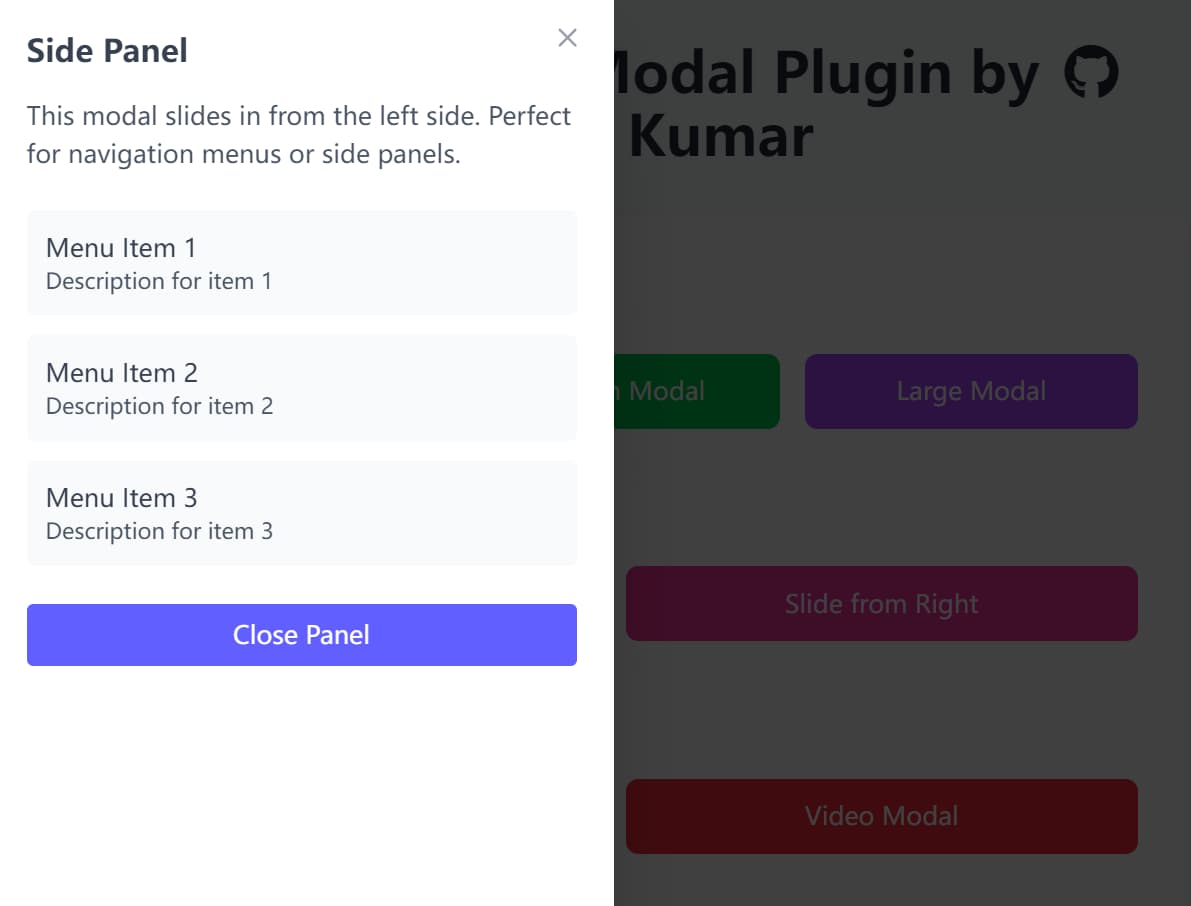
<div id="modalExample" class="modal" data-type="slide-right" data-width="400"> ... Modal Content Here ... </div> <div id="modalExample" class="modal" data-type="slide-left" data-width="360"> ... Modal Content Here ... </div>
3. Use the 'data-type' attribute to embed images or Youtube videos into the modal.

<div id="modalExample" class="modal" data-type="image" data-img="1.jpg" data-alt="Image Alt">
</div>
<div id="modalExample" class="modal" data-type="video" data-video="https://www.youtube.com/watch?v=TeBW6euWE6U">
</div>
4. Don't forget to create a trigger button to toggle your modal windows.
<button data-modal-target="#modalExample"> Launch Modal </button>
5. Initialize the modal plugin with default options.
$(document).ready(function() {
$('.modal').TailwindModal();
});
6. Available configuration options to customize your modal windows.
background: Sets the modal's background color.textColor: Defines the text color inside the modal.overlayColor: Changes the color and opacity of the backdrop.animation: A boolean to enable or disable open/close animations.closeButton: Display close button in modal header.closeOnBackdrop: A boolean that determines if a click on the overlay closes the modal. We find this is a user experience must-have.closeOnEscape: A boolean to allow closing the modal with the ESC key.videoAutoplay: A boolean to automatically play videos when the modal opens.imageZoom: A boolean to enable click-to-zoom for image modals.
$(document).ready(function() {
$('.modal').TailwindModal({
background: '#ffffff',
textColor: '#374151',
overlayColor: 'rgba(0, 0, 0, 0.75)',
borderRadius: '0.5rem',
animation: true,
closeButton: true,
closeOnBackdrop: true,
closeOnEscape: true,
videoAutoplay: true,
imageZoom: true,
});
});
7. Callback functions.
$(document).ready(function() {
$('.modal').TailwindModal({
onOpen: null,
onClose: null,
onShow: null,
onHide: null
});
});
8. Control modal windows programmatically using the following JavaScript API:
// Show modal
$('#modalExample').TailwindModal('show');
// Hide modal
$('#modalExample').TailwindModal('hide');
// Toggle visibility
$('#modalExample').TailwindModal('toggle');
// Update configuration
$('#modalExample').TailwindModal('option', 'closeOnBackdrop', false);
// Destroy modal instance
$('#modalExample').TailwindModal('destroy');
FAQs
Q: How do I prevent modal content from scrolling the background page?
A: The plugin automatically adds the overflow-hidden class to the body element when modals open, preventing background scrolling. This behavior is built-in and doesn't require additional configuration. The class is removed when the modal closes.
Q: How do I customize the modal animations?
A: The plugin uses CSS transitions for animations, so you can override the default styles in your CSS file. Target the .modal-backdrop, .modal-content, and type-specific classes like .modal-slide-left to customize animation timing, easing, and effects.
Q: What happens if JavaScript is disabled?
A: The modals won't function without JavaScript, but the content remains accessible as regular page elements. Consider implementing progressive enhancement by placing modal content in a way that makes sense when rendered inline, then using CSS to hide it when JavaScript is available.
Q: Can I open a modal programmatically without a user clicking a button?
A: Yes. Once the plugin is initialized on an element, you can use the JavaScript API to control it. Just call $('#yourModalId').TailwindModal('show'); from your script to open it.
This awesome jQuery plugin is developed by iamitpkumar. For more Advanced Usages, please check the demo page or visit the official website.
